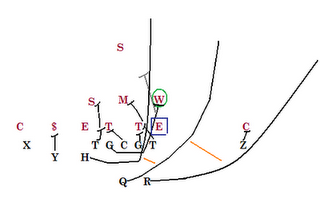 The coaching staff is putting in the work.
The coaching staff is putting in the work.The last two weeks I have discussed the relatively new idea of combining a run and pass play together and letting the QB make a decision post-snap by reading a defender. In part 1 I examined the theory behind the concept. In part 2 I looked at how this idea has been applied.
Now I want to examine how Ohio State might implement the concept this fall. Ohio State will feature flash and bubble screens as Urban Meyer and Tom Herman's offenses have for years. But it also appears that Ohio State will go beyond that in combining concepts. Though the returns are early, OSU has demonstrated inklings of combining run-pass options that could prove effective for the Buckeyes this fall.
Stick with Power
One hint we saw this spring was a combination of stick with the 'Power O' play. The concept is similar to Dana Holgorsen's stick-draw combination, but with Meyer's typical power twist.

The read is the same. The quarterback reads the front side linebacker. If he does not widen the QB quickly throws the stick route. If the linebacker does extend out, however, the quarterback will turn and hand to the running back for power. The offense can then run power with the additional benefit that the front side fill linebacker has vacated his responsibilities, which should open a large gap behind the power kick out block.
Shovel Option with Sprint Out Pass
One intriguing possibility raised by Chris Brown is combining the play Urban Meyer has made famous--the shovel option--with a sprint out pass. Meyer did not create the shovel option, but it perfectly fits his philosophy--spreading people out while combining power and option concepts. The line blocks "power" while leaving the front side end unblocked for the quarterback to option off of.

The defensive end will often attack upfield, opening up the shovel pass coming underneath. As Brown discusses, though, teams have gotten better at defending the play by having the defensive end squeeze down on the shovel. When this happens, the quarterback has to extend the option outside, but often the relationship of the speed option is off as the quarterback has to wait for the shovel to develop.
Teams have thus increasingly been combining the shovel option with a sprint out pass. As Brown describes:
Enter the shovel option-sprint-out. Here, the first read by the quarterback is still the shovel option: If the defensive end comes upfield, the quarterback simply tosses the shovel pass and the play goes on as normal. But if the defensive end squeezes and takes away the shovel, what exactly has happened? Well, it’s the easiest seal block ever on that defensive end; instead of trying to have an H-back crack down or the tackle reach him, the quarterback should have enough space on the corner to simply run around him because of how he has played the option.
It’s at this point that the second read kicks in, which is some basic combination route concept. I’ve drawn up curl/flat here, but it could be smash or anything else depending on the coverage tendencies from the opponent. The important thing is it should be a simple read, as the idea for the quarterback is he must make a quick decision and get rid of the ball.

The quarterback must remember that the defensive end is unblocked, so he must quickly get out of the pocket and throw on the run. But the purpose is not to sit in the pocket and throw the ball down field. Instead, it is to attack a defense that overplays the shovel and give the quarterback options to do so.
Both concepts are typical Meyer--taking advantage of new ideas permeating football but yet underlying them them with traditional power football. Both concepts use the same 'power' (Dave) blocking formula, limiting concepts that the offensive line must learn. This increases practice reps while forcing a defense to worry about more things and defend the entire field, fitting perfectly within Meyer's offensive philosophy.

